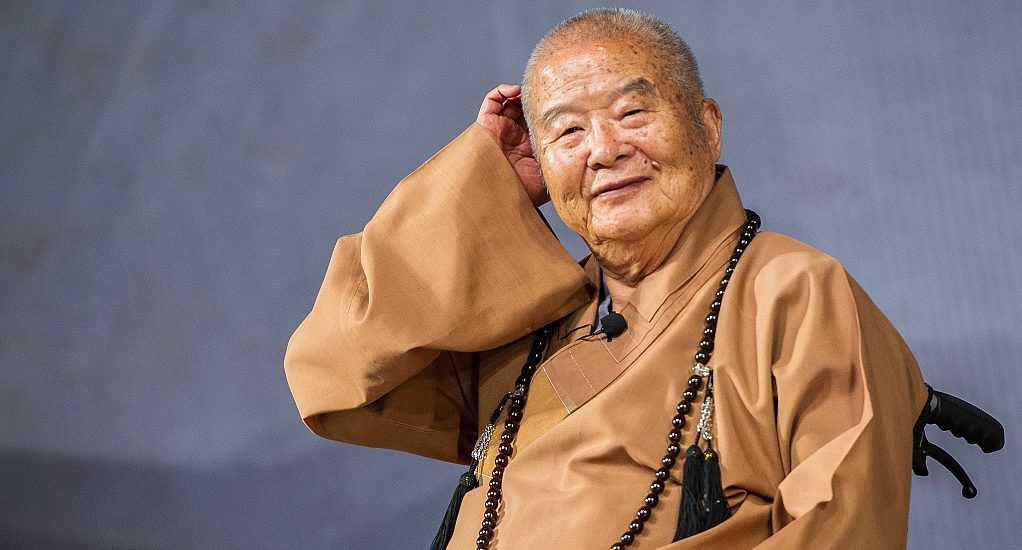Pioneer and Philosopher of Buddhism for the Present
Master Hsing Yun passed away yesterday.
Almost every contemporary Buddhist knows of his immense accomplishments, including his founding of Fo Guang Shan – one of the “big four” Buddhist institutions of Taiwan – and his coining of humanistic Buddhism, what he fondly called “Buddhism for the living” rather than for the deceased. As he put it, the core goal of humanistic Buddhism was to walk the path of the bodhisattva, which in Master Hsing Yun’s eyes was an endearing person, full of drive and vitality, who sought enlightenment and did their best to help others find it. Humanistic Buddhism, for Master Hsing Yun, embraced without hesitation the issues of this world, bringing enlightenment to the people of now rather than elsewhere or another time. Its core concern is relevance and relatability.
Unfortunately, Chinese Buddhism has few groundbreaking pioneers and popularisers to speak of on the contemporary global stage. Yet Master Hsing Yun was exactly this, and perhaps among the first in the post-World War Two context. In many ways, he seemed to be even more effective than many Chinese monastics that settled in the West, despite having stayed in East Asia for the vast portion of his life.
Born on 19 August 1927, he was born in Jiangdu, Jiangsu Province, during a period that saw China split between bickering warlords that were ill-prepared for the looming Second Sino-Japanese War (and later on, the Pacific theatre of World War II) that would come just ten years later. His early life could have thrown him into a deep psychological and emotional darkness, yet it is a testament to his character and clear-sightedness that he identified the root cause of the world’s agony and decided that the path of Dharma was the best answer for not just himself but those around him.
Growing up in poverty and separated from his parents early on, he entered a monastery at age 12. By 1938 he was tonsured by the eminent Master Zhi Kai in Qixia Temple, Nanjing, with Dajue Temple in Yixing, Jiangsu, as his ancestral temple. He was fully ordained in 1941 as the 48th patriarch of the Linji school of Chan Buddhism. He then spent a further decade studying Vinaya, Chan, and doctrinal aspects of Buddhism, before graduating from Jiaoshan Buddhist College in 1947. He arrived on the island of Taiwan in 1949, as Mao Zedong’s Communists claimed victory over Chiang Kai-shek’s Nationalists.
Many religion journalists and Buddhist writers will have voluminous details about his many accomplishments. But it was the Fo Guang Shan Buddhist Order, founded in 1967, that he will justifiably be most remembered for. Not only was it is vehicle for promoting his ideal of humanistic Buddhism, but its model of propagating Dharma was so successful that it was to influence Taiwan’s entire self-understanding of Buddhism and what it meant to practice this “traditional” faith. Organisations like Dharma Drum Mountain, Tzu Chi, and Chung Tai Shan would come to wield similar weight, in their own ways, but it was Fo Guang Shan that set the stage.
Closer to my heart, he founded Nan Tien Temple in New South Wales, Australia, along with several other major Chinese Buddhist temples around the world: Hsi Lai Temple in California in the US, Nan Hua Temple in South Africa, and Zu Lai Temple in Brazil. This is on top of the dozens and dozens of colleges, schools, institutes of care, bookshops, and so much more that he established globally. We will explore some of these locations in a future post. His publications, including periodicals, books, articles, and published speeches, are the main source for understanding what humanistic Buddhism means.
Master Hsing Yun, in the true reformist tradition that went back all the way to Master Taixu, was especially adamant in correcting misconceptions about Buddhist practice. Such practices were certainly there to assist in the process of dying, and he wrote frequently about the right way to go about it. But he also wanted to correct the way people did Buddhist ritual; that these rituals and ceremonies were expressly for the benefit of the living and for them to build communities of practice and mutual compassion. After all, Master Hsing Yun noted, that it is the living that suffer and need the teachings of the Buddha, and death itself is no respite from the cyclical travails of samsara. Buddhists needed to aim the merits and good deeds they wanted to accumulate squarely at those still with us.
His urgings that Chinese Buddhism adopt a more universalist approach were borderline prophetic. Were it not for leaders like him, would there even be a conversation in today’s Chinese Buddhism about how best to reform the tradition and reach newer and more skeptical generations?
He passed away earlier yesterday, on 5 February 2023.


